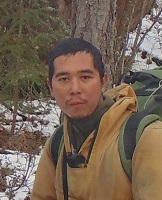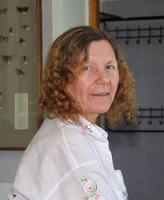Results of historical seismological analysis of Tuvan folklore for seismic risk assessment of Tuva Republic
DOI:
https://doi.org/10.25178/nit.2018.3.12Keywords:
Tuva; Tuvan folklore; earthquake; myth; legend; toponyms; toponymy of Tuva; geographyAbstract
Historical seismology, as a synthetic scientific discipline that studies information about earthquakes in written and oral historical sources, has promising prospects for development in Tuva, as the region lies in a seismically active zone. Plenty of material for research can be found in folklore and toponymy of Tuva. This information will help solve several important problems, such as the territorial distribution of earthquakes, determining their maximum strength, possible repetition intervals, etc. The article presents an analysis of the first few cases of unravelling information about ancient earthquakes in Tuva found in published folklore and toponymic sources.
The story of the Kogey-Syny (the Tuvan name of the Khan-Khuhei Range in Mongolia) tells about the disputes between the Tuvans and the Mongolians of the Tuvan Khan-Khuhei mountains, after which an earthquake occurred, and a tectonic rift appeared along the Khan-Khuhei Range. It was decided to draw the border along the line of this gap. Obviously, it was the Bolnai earthquake (July 23, 1905, magnitude 8.2 – 8.5). In the legend of Hun-Korbes (a mountain near the Kaachem system of active rifts), lovers jumped from a high cliff, then a noisy rockfall happened. It obviously refers to a landfall after the earthquake, which occurs here every 300-500 years. There are also myths about the origin of names of certain geographical areas.
The authors studied the geographical names of Western Tuva to identify signs possibly associated with any catastrophic events in the area. Provided in the article is a list of the most interesting place names from "A Toponymic Dictionary of Tuva" by B. K. Ondar (2007). They reflect the catastrophic land-forming processes along the Sayano-Tuva rift.
The examples here form only a small part of the huge folklore heritage, which can and should be used to identify and reconstruct the natural events of the past. For a more accurate interpretation of folklore data, detailed field works using the methods of paleo- and archaeoseismology is required.
References
Arzhannikov, S. G. (1998) Seismotektonika Vostochno-Tuvinskogo nagor'ia[Seismotectonics of the East Tuva Plateau]: Thesis of Diss. … Candidate of Geological and Mineralogical Sciences. Irkutsk. 16 p. (In Russ.)
Alekseev, N. A. (2008) Etnografiia i fol'klor narodov Sibiri [Ethnography and folklore of the peoples of Siberia]. Novosibirsk, Nauka. 494 p. (In Russ.)
Borisenkov, E. P. and Pasetskii, V. M. (1988) Tysiacheletniaia letopis' neobychainykh iavlenii prirody[The millennial annals of extraordinary natural phenomena]. Moscow, Mysl'. 524 p. (In Russ.)
Vdovin, V. V. and Zelenkov, P. Ia. (1982) Seismogennye formy rel'efa Tuvy i Zapadnogo Saiana. Zakonomernosti razvitiia rel'efa Severnoi Azii [Seismogenic relief in Tuva and Western Sayans. Regularities of the development of the relief of North Asia]. Ed. by Nikolaev, V. A. and Florensov, N. A. Novosibirsk, Nauka. P 160. (In Russ.)
Voznesenskii, A. V. (1906) Doklad o poezdke v Mongoliiu dlia issledovaniia ochagov zemletriasenii 9-go i 23-go iiulia 1906 goda [Report on a trip to Mongolia for the study of earthquake foci on July 9th and July 23rd, 1906]. Izvestiia Postoiannoi tsentral'noi seismicheskoi komissii, vol. II, no. 3, pp. 83–92. (In Russ.)
Grebnev, L. V. (1960) Tuvinskii geroicheskii epos: Opyt istoriko-etnograficheskogo analiza [Tuvan heroic epic: The experience of historical and ethnographic analysis]. Moscow, Nauka. 256 p. (In Russ.)
Kuular, D. S. (1996) Kys-Khalyyr: Tyva ulustuң toolchurgu bolgash tөөgү chugaalarynyң chyyzhyzynyң katap үndүrүlgezi [Maiden Rock: Tuvan folk legends and tales]. Kuular, D. S. and Kuular Ch. Ch. Kyzyl, Tuvin. kn. izd-vo. 157,[2] p. (In Tuv.).
Mify, legendy, predaniia tuvintsev [Myths, legends and traditions of Tuvans] (2010). Comp. by Alekseev, N. A., Kuular, D. S., Samdan, Z. B. and Iusha, Zh. M. Novosibirsk, Nauka. P 372. (In Russ.)
Nikonov, A. A. (1983) Zemletriaseniia v legendakh i skazaniiakh [Earthquakes in legends and tales]. Priroda, no 11, pp. 66–75. (In Russ.)
Ovsyuchenko A. N. and Butanaev Yu. V. Seismic history of the Altai-Sayan region and the 2011-2012 earthquakes in Tuva. The New Research of Tuva, no. 1 [online] Available at: https://nit.tuva.asia/nit/article/view/703 (access date: 03.03.2018). DOI: 10.25178/nit.2017.1.11
Ovsiuchenko, A. N., Butanaev, Iu. V., Marakhanov, A. V., Lar'kov, A. S., Novikov, S. S. and Kuzhuget, K. S. (2017) O povtoriaemosti sil'nykh seismicheskikh sobytii v raione tuvinskikh zemletriasenii 2011–2012 gg. po dannym paleoseismologicheskikh issledovanii [On the frequency of strong seismic events in the area of the Tuva earthquakes in 2011-2012, according to the data of paleoseismological research]. Geologiia i geofizika, vol. 58, no 11, pp. 1784–1793. DOI: 10.15372/GiG20171112 (In Russ.)
Ondar, B. K. (2007) Toponimicheskii slovar' Tuvy.[Toponymic dictionary of Tuva]. 2nd ed. Kyzyl, Tuvinskoe knizhnoe izdatel'stvo. 552 p. (In Russ.)
Panin, A. V. (2011) Pervye dannye o pozdnegolotsenovoi seismike iugo-zapadnogo zamykaniia Baikal'skoi riftovoi zony [The first data on the late Holocene seismic of the southwestern closure of the Baikal rift zone]. Doklady Akademii Nauk, vol. 438, no 1, pp. 76–81. (In Russ.)
Samdan, Z. B. (2016) Mif v fol'klornoi traditsii tuvintsev: (formy bytovaniia, siuzhetnyi sostav, sistema personazhei) [Myth in the folklore tradition of the Tuvinians: forms of existence, story structure, character system]. Novosibirsk, Nauka. 180 p. (In Russ.)
Saf'ianov, I. G. (2012) Tuva v proshlom: v 2-kh t. [Tuva in the past: in 2 vols.] Moscow, Tuvinskiy institut gumanitarnykh issledovaniy. Vol. 1. Khudozhestvennoe tvorchestvo tuvinskogo naroda [Art of Tuvan people]. 232 p. (In Russ.)
Superanskaia, A. V. (2014) Chto takoe toponimika? Iz istorii geograficheskikh nazvanii [What is toponymy? From the history of geographical names]. Ed. by Stepanov, G. V. Stereotypical edition. Moscow, Knizhnyi dom «LIBROKOM». 178 p. (In Russ.)
Tudenov, G. O. (1986) O zonal'noi obshchnosti formirovaniia eposa narodov Tsentral'noi Azii i Iuzhnoi Sibiri. Kul'tura Mongolii v srednie veka i novoe vremia. [Culture of Mongolia in the Middle Ages and Modern Times]. Ed. by Chimitdorzhiyev, Sh. B. et al. Ulan-Ude, BF SO AN SSSR. 160 p. Pp. 84–104. (In Russ.)
Khapaev, V. V. (2008) Pis'mennye istochniki po istorii Krymskikh zemletriasenii antichnogo i srednevekovogo periodov [Written sources on the history of the Crimean earthquakes of the ancient and medieval periods]. Uchenye zapiski Tavricheskogo natsional'nogo universiteta. Seriia «Istoriia». Vol. 21 (60), no 1, pp. 3–8. (In Russ.)
Khil'ko, S. D., Kurushin, R. A., Kochetkov, V. M., Misharina, L. A., Mel'nikova, V. I., Gileva, N. A., Lastochkin, S. V., Balzhinniam, I. and Monkhoo, D. (1985) Zemletriaseniia i osnovy seismicheskogo raionirovaniia Mongolii [Earthquakes and the basics of seismic zoning of Mongolia]. Ed. by Solonenko, V. P. and Florensova, N. A. Moscow, Nauka. 244 p. (In Russ.)
Chernov, G. A. (1978) K izucheniiu seismogeologii i neotektoniki Altae-Saianskoi gornoi oblasti. Seismogeologiia vostochnoi chasti Altae-Saianskoi gornoi oblasti [Seismogeology of the Eastern part of the Altai-Sayan mountain region]. Ed. by Solonenko, V. P. and Nikolaev, V. A. Novosibirsk, Nauka. 104 p. Pp. 6–27. (In Russ.).
Historical and prehistorical earthquakes in the Caucasus (1997) / D. Giardini, S. Balassanian, ed. Dordrecht. Boston, Kluwer Academic Publishers. 545 p.
Tatevossian, R. (2004) History of earthquake studies in Russia. Annals of Geophysics, vol. 47, no. 2–3, pp. 811–830.
Radziminovich, Ya. B. and Shchetnikov, A. A. (2013) Historical earthquakes studies in Eastern Siberia: State-of the-art and plans for future. Journal of Asian Earth Sciences, vol. 62, pp. 134–145. DOI: 10.1016/j.jseaes.2012.09.017
Published
How to Cite
Issue
Section

Author(s) license holder(s) grant rights for their work to the journal (grantee of a license) under the simple non-exclusive open license in accordance with Art. 1286.1 «Open license for a research work, work of literature or fine arts», Civil Code of the Russian Federation.
New Research of Tuva publishes articles under the Creative Commons Attribution-NonCommercial license (CC BY-NC).
Since it is an open license, author(s) reserve the right to upload the article to their institutional repository, submit it to another journal (if it allows republications), or republish it on their own website (in full, or in part).
However, several conditions apply here:
a) The republished version must always contain the name(s) and affiliation(s) of the author(s), the original title and the hyperlink to the original version on the New Research of Tuva website;
b) It must be in open access, free of charge, and no category of readers must be in any way whatsoever advantaged over general readership.
c) should the contribution be submitted elsewhere by its author(s) without substantial modification (30% or more of original text unchanged), the body of the article should contain a disclaimer that the original version was published in New Research of Tuva (with a link to the respective page)
The CC-BY-NC is a non-revocable license which applies worldwide and lasts for the duration of the work’s copyright.










